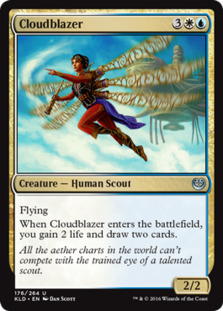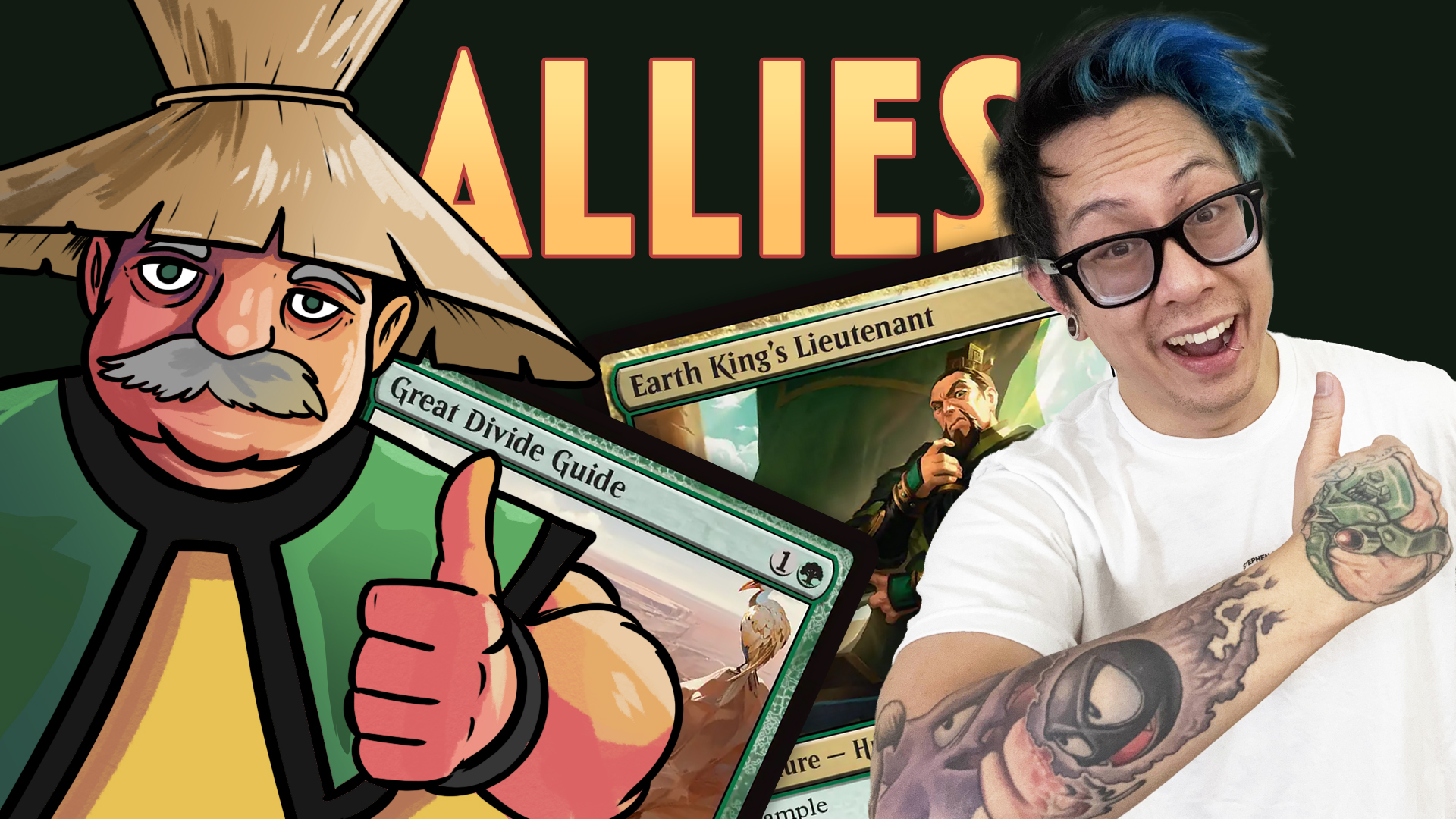Budget Magic: $96 (39 tix) Modern Pan-Meria
Kamusta, Budget Magic lovers, it's that time again! Next week, we'll start our exploration of the new Amonkhet Standard format, and I can't wait. It seems like it's been forever since we've played a Standard Budget Magic deck. The good news is that I'm super excited for this week's deck too! While we wait for Amonkhet, we'll be giving my favorite card from Kaladesh block one more chance to shine—this time, in Modern!
When Panharmonicon first came out, one of the most common questions people asked was if it would work in Modern Emeria. At the time, it didn't seem like it was worth it. The biggest challenge for Emeria decks is making it to the late game, and Panharmonicon doesn't really fix this issue, instead just adding even more late-game power. However, Aether Revolt changed things with the addition of Felidar Guardian, which is not only a natural fit for Emeria, by offering additional blink triggers, but also allowing for an infinite combo with Panharmonicon that closes out the game quickly. For Emeria decks, this is actually pretty helpful, since the deck is so slow. Having a way to randomly win on Turn 5 or 6 gives the archetype an entirely new line of attack. Plus, it's a ton of fun! So, this week, we are heading to Modern to play a deck that's essentially a mashup of Panharmonicon and Mono-White Emeria: Pan-Meria! Let's get to the videos, and then we'll talk more about the deck.
First, a quick reminder: if you enjoy the Budget Magic series and the other video content on MTGGoldfish, make sure to subscribe to the MTGGoldfish YouTube Channel to keep up on all of the latest and greatest.
Pan-Meria Deck Tech
Pan-Meria vs. Soul Sisters
Pan-Meria vs. UW Control
Pan-Meria vs. Eldrazi Tron
Pan-Meria vs. Merfolk
Pan-Meria vs. Grixis Death's Shadow

The Deck
![]()

The namesakes Panharmonicon and Emeria, the Sky Ruin are the two cards that give our deck its power. Since our deck is overloaded with creatures with enters-the-battlefield abilities, both have the potential to take over the game in short order. Panharmonicon helps us stabilize as we play our creatures, and then eventually turns into a game-ending combo piece, allowing us to gain infinite life, draw our entire deck, make an infinite number of tokens, or Strip Mine our opponent out of the game. It also helps us turn on our Emeria, the Sky Ruin by doubling the triggers of Knight of the White Orchid and Pilgrim's Eye. Meanwhile, Emeria, the Sky Ruin gives us a great way to close out the game if it goes long by reanimating a creature for free every turn. It also works well with Panharmonicon by allowing us to combo off from our graveyard by getting back creatures that died earlier in the game.
The bad news about both cards is they are fairly slow. While Panharmonicon can let us combo off on Turn 5, this isn't really fast by Modern standards, and Emeria, the Sky Ruin is just an enters-the-battlefield tapped land until we get seven Plains. Thankfully, the rest of our deck is designed to slow down the game and help us live long enough to get our value engines online.


Knight of the White Orchid and Pilgrim's Eye give us blockers in the early game that also help us hit our land drops to turn on Emeria, the Sky Ruin as quickly as possible. While neither card is especially powerful as a creature, they both have the additional upside of working with Panharmonicon (although Knight of the White Orchid is conditional and actually somewhat hard to double trigger, unless we are super-far behind on lands) by allowing us to search up two lands instead of just one.


Lone Missionary and Blade Splicer help us stabilize the board over the early turns while we are waiting to draw Panharmonicon or get enough lands to turn on Emeria, the Sky Ruin. Lone Missionary does this by gaining us four life (and eight life with Panharmonicon), which might not seem like much but is actually super helpful against aggressive decks. Meanwhile, Blade Splicer makes two blockers, allowing us to chump twice to keep our life total high while we are getting our engine cards online. Both cards can also turn into combo pieces in the late game, but more on this in a minute.


Wall of Omens is another stabilization card, but instead of gaining life, making a token, or finding a land, it draws us a card when it enters the battlefield, which makes it insane with Panharmonicon. With one Panharmonicon out, it turns into a two-mana Divination that can block; with two, it's a Concentrate; and with three, it's an Opportunity—all just for two mana! Sun Titan does some of the same tricks but also offers us a massive body to lock down the ground, can get back all of the creatures we've talked about so far (as you probably have noticed), and double triggers with Panharmonicon for some absurd value. Plus, it gives us access to all the typical Emeria, the Sky Ruin loops with our next card: Flickerwisp.
Blinkin' and Flickerin'

Flickerwisp is one of the most powerful cards in our deck. On Turn 3, it can blink a Wall of Omens or Knight of the White Orchid to get an extra enters-the-battlefield trigger, and in the late game, it can do some really powerful things with Panharmonicon allowing it to blink out a bunch of our opponent's permanents. It's also best friends with Sun Titan. By the time Sun Titan comes down, it's not all that uncommon to have a Flickerwisp in the graveyard, which means we can reanimate the Flickerwisp with Sun Titan; then, when Sun Titan comes back at the end of our turn, it can reanimate something else for double the value. Throw in a Panharmonicon so everything triggers twice, and things will really get out of hand!


The downside of Felidar Guardian and Restoration Angel is that we can't get them back from the graveyard with Sun Titan, but their upside (especially with Panharmonicon) is immense. On one hand, they work a lot like Flickerwisp, coming down on Turn 4 to blink a Wall of Omens, Blade Splicer, or other "enters the battlefield" creature so we can reuse the trigger. While this is great and can sometimes win us games all by itself (especially with the help of Panharmonicon), this package also allows us to go infinite with Panharmonicon.
The Loops
![]()


To go infinite, we need a Panharmonicon, at least one Felidar Guardian, and one more of either Felidar Guardian or Restoration Angel. With this setup, we can use one Felidar Guardian / Restoration Angel trigger to blink the other Felidar Guardian, and since Panharmonicon gives us an extra "blink" trigger, we can use that to target something else. Then, we simply do this over and over again until we win the game. One thing I realized while playing the deck is that actually winning with the combo is more complicated than it looks (although we generate so much value that it's hard to lose once we start comboing off, even if we don't win the game that turn), so let's take a minute to talk about the different things we can do with the combo. All of these are based on the card being the target of the "extra" blink trigger, with the first target being the other copy of Felidar Guardian / Restoration Angel.
- Lone Missionary gains us infinite life, which might not win us the game directly but makes it really hard to lose, especially since Infect is no longer a popular deck, so most decks are looking to win with damage in one way or another.
- Blade Splicer makes an infinite number of 3/3 Golem tokens that we can use to beat our opponent down.
- Wall of Omens allows us to draw our entire deck, which can sometimes be important in finding additional combo pieces.
- Flickerwisp is where things start to get a bit convoluted but very fun. The main benefit of comboing off with a Flickerwisp on the battlefield is that it allows us to manipulate the timing of the combo. If we start by blinking the Flickerwisp and using Flickerwisp to flicker our Felidar Guardian, we can "combo off" at the end of our turn when the Felidar Guardian comes back from the Flickerwisp ability. Why does this matter? Because it allows us to soft lock our opponent out of the game! When we go infinite on our end step, we can blink the Flickerwisp enough times to exile all of our opponent's permanents—lands, creatures, planeswalkers, everything—which basically makes them skip their next turn and makes sure they can't kill our board with sorcery-speed wraths or sweepers. Then, we can simply kill them the next turn with our board full of creatures.
- Sun Titan is our primary finisher. When we go infinite with Sun Titan, we can reanimate something an infinite number of times, and while this can allow us to get back any of our creatures that have died over the course of the game, the main plan is to keep getting back a Ghost Quarter and sacrificing the Ghost Quarter in between to kill one of our opponent's lands. Sooner or later, our opponent will run out of basic lands, at which point Ghost Quarter turns into Strip Mine, so we can slowly Armageddon away all of our opponent's lands, making it impossible for them to win!
Removal

Our last main-deck card is Path to Exile, which gives us a way to deal with any of our opponent's creatures permanently. While it's mostly just a really good removal spell, there are also some tricks for our deck. For one thing, we can use Path to Exile like a Rampant Growth, exiling one of our own creatures to get another Plains to turn on Emeria, the Sky Ruin. Also, it's worth remembering that Path to Exile gives our opponent a land, which sometimes matters with Knight of the White Orchid (since the Knight only triggers if our opponent has more lands than we do, so we can use Path to Exile to give our opponent a land, knowing we can make up the advantage with the help of Knight of the White Orchid).
Wrap-Up
And that's pretty much the deck. It's important to realize that while comboing off is awesome and a ton of fun, it's not always necessary to win the game. In fact, we probably win more often by just valuing our opponent out of the game by blinking Wall of Omens, Blade Splicer, and Flickerwisp, hopefully with a Panharmonicon on the battlefield. So, rather than playing for the combo, I tend to play the deck like Mono-White Emeria and then take advantage of the combo when we happen to draw into it. The best part is that all of the combo pieces are between good and great in our deck, even when we aren't comboing off, so rather than needing the combo to win, the combo is more of a nice bonus that does occasionally allow us to win games we otherwise would lose.
On the other hand, it is important to be aware of the combo potential. In one of the games we lost to Merfolk, we chumped with a Lone Missionary with a Panharmonicon on the battlefield and a Felidar Guardian in hand. While it made sense at the time to keep our life total as high as possible, we would have survived the attack even without chumping. Of course, the next turn, we drew a second copy of Felidar Guardian, which would have allowed us to make infinite life if the Lone Missionary were still on the battlefield. In this situation, the combo was our main out, and it was a major (and costly) mistake to not play in the hopes of drawing into it, even though the odds were not in our favor.
All in all, we finished 3-2 in our video matches and 3-3 overall (I remember losing an extra match with the deck, but I don't actually remember what we were playing—probably Tron). We managed to beat anything even slightly slow or controlling, while struggling against Merfolk (where our lack of interaction was a problem). Against most aggro decks, we can clog up the board, gain some life, and win, but the islandwalk ability of Merfolk specifically makes it a hard matchup without tons of removal), and against Eldrazi Tron (where we ran pretty poorly; plus, we never beat Tron, no matter what we are playing). The combos were awesome, the deck was a ton of fun to play, and it felt competitive enough to take to an FNM or play on Magic Online and expect to win some matches. Give it a shot; I don't think you'll be disappointing!
Ultra-Budget Pan-Meria

The ultra-budget version of Pan-Meria mostly involves a lot of trimming. We lose one copy of Restoration Angel (replaced with a Stonehorn Dignitary in the main deck), one Sun Titan (replaced with an extra Blade Splicer), and all of our Path to Exiles (replaced mostly with Condemn). The main problem with cutting the budget this way is that it reduces the consistency of the deck, but in this case, we really don't have another option, since the other somewhat expensive cards are the namesake Panharmonicon and Emeria, the Sky Ruin. All in all, this version of the deck shouldn't play much differently—just be warned that you'll draw your Sun Titans and combos slightly less often thanks to the cards we cut. That said, the deck should still have enough power to compete thanks to Panharmonicon and Emeria, the Sky Ruin, especially if you are just playing for fun.
Non-Budget Ideas



I don't actually have a non-budget list for you this week, but I do have some ideas on possible upgrade paths. Normally for Mono-White Emeria decks, the next step is to go blue-white (here's an example we played on Much Abrew a while ago). While it's possible to go this route with Pan-Meria, I'm not sure it's necessarily better than staying mono-white. The problem is that the main reason to go blue-white is to add more control elements like Supreme Verdict, Ojutai's Command, and Negate, and it's hard to find room for all of our Panharmonicon combos and still add a bunch of non-creature spells. That said, Mulldrifter seems sweet, Cloudblazer could be an option, and Court Hussar is great in the deck, basically being a repeatable Anticipate with Sun Titan and a double Anticipate with Panharmonicon.



The other possibility is to forget about Emeria, the Sky Ruin altogether, which frees up the deck to go a bunch of different directions. Running cards like Thought-Knot Seer and Eldrazi Displacer would be amazing in our deck, but there simply isn't a way to keep our Plains count high enough for Emeria, the Sky Ruin and still run enough colorless mana to cast Eldrazi. I'm not 100% sure whether this tradeoff is worth it or not. I'm also not sure what the deck would look like. In theory, we could just trim the land-tutor cards like Knight of the White Orchid and Pilgrim's Eye (which are much worse without Emeria, the Sky Ruin), toss in some colorless lands, and run some Eldrazi. On the other hand, it's possible the deck morphs into something similar to Eldrazi and Taxes but with more enters-the-battlefield effects over lock pieces like Leonin Arbiter and Thalia, Guardian of Thraben. I think both are worth exploring, but I don't really feel comfortable posting a list until I get a chance to test some of the ideas and see what works. If you have some ideas of your own or a list, make sure to let me know in the comments!
Conclusion
Anyway, that's all for today. As always, leave your thoughts, ideas, opinions, and suggestions in the comments. You can reach me on Twitter@SaffronOlive or at SaffronOlive@MTGGoldfish.com.













